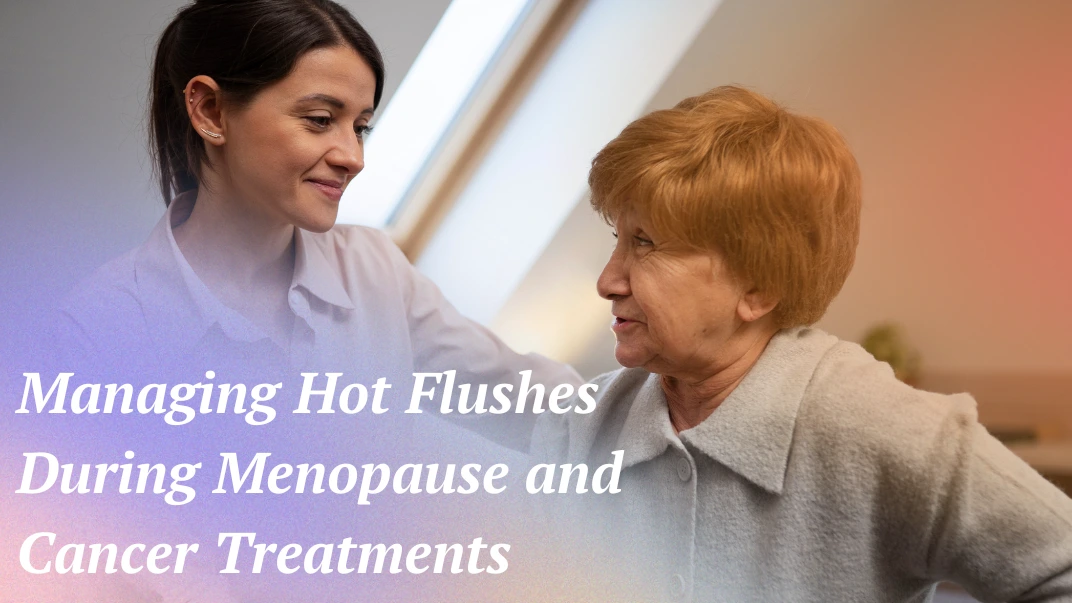November 23, 2024

Hot flushes, also known as hot flashes, are among the most common and challenging symptoms experienced during menopause and cancer treatments. For many, these sudden waves of heat, accompanied by sweating and discomfort, can disrupt daily life and quality of sleep. When combined with the physical and emotional toll of cancer treatments, managing hot flushes becomes even more essential.
In this article, we explore the causes of hot flushes in menopause and cancer recovery, discuss why they occur, and provide evidence-based strategies and tips to help improve comfort and well-being.
Hot flushes are sudden feelings of warmth that typically affect the face, neck, and chest. They often occur without warning and can last from a few seconds to several minutes. While commonly associated with menopause, they are also a frequent side effect of cancer treatments, especially those that affect hormone levels.
Hot flushes occur due to fluctuations in hormone levels, which disrupt the body’s thermoregulation process. Here’s how they manifest during menopause and cancer treatments:
Menopause marks the end of a woman’s reproductive years and is characterized by a decline in estrogen levels. This hormonal change impacts the hypothalamus, the part of the brain that regulates body temperature. The hypothalamus may perceive normal body temperature as too high, triggering a heat-releasing response.
For individuals undergoing cancer treatments, hot flushes can be a side effect of therapies that alter hormone levels or disrupt the endocrine system.
Hot flushes, particularly when severe or frequent, can significantly affect physical, emotional, and social well-being. Common challenges include:
Understanding the underlying causes and finding effective management strategies is essential for improving quality of life.
Simple changes to daily routines can help reduce the frequency and intensity of hot flushes:
Common triggers include:
Keeping a symptom diary can help identify specific triggers and patterns.
Drinking plenty of water can help regulate body temperature and replenish fluids lost through sweating.
Engage in moderate physical activity, such as walking, yoga, or swimming. Regular exercise helps stabilise hormone levels, improve mood, and enhance overall health.
For individuals who cannot use hormone replacement therapy (HRT) due to cancer or other medical conditions, non-hormonal treatments can be effective:
Stress can exacerbate hot flushes, making stress management a critical part of treatment:
CBT helps individuals change their response to hot flushes, reducing their emotional impact and improving coping strategies.
Mindfulness practices, such as deep breathing or progressive muscle relaxation, can help calm the nervous system during a hot flush episode.
Joining support groups or connecting with others experiencing similar challenges provides emotional reassurance and practical advice.
Complementary therapies may provide additional relief for those seeking non-traditional options:
Studies suggest acupuncture may help reduce the frequency and severity of hot flushes, particularly in cancer survivors.
Essential oils like peppermint, lavender, and clary sage can promote relaxation and cooling effects.
Cooling teas, such as chamomile or peppermint, offer hydration and a soothing effect.
For individuals recovering from cancer, managing hot flushes requires a customised approach. Many cancer treatments eliminate the possibility of hormone replacement therapy due to the risk of recurrence. Here’s how cancer survivors can navigate this challenge:
Hot flushes during menopause and cancer treatments can be challenging, but with the right strategies, they can be effectively managed. From lifestyle changes and medical treatments to stress management and holistic approaches, there are numerous options to explore. Collaborating with healthcare providers and adopting a proactive approach can significantly improve comfort and well-being.
Remember, every individual’s experience is unique, and finding the best combination of treatments may take time. With patience, persistence, and support, it is possible to regain control and embrace life with confidence.